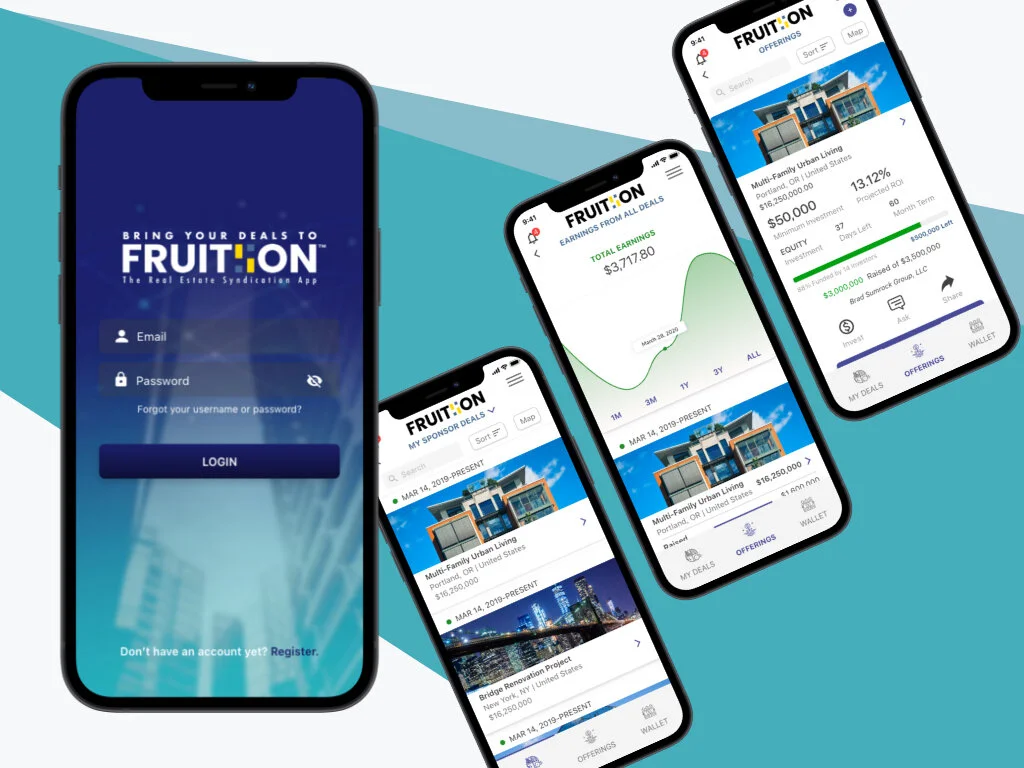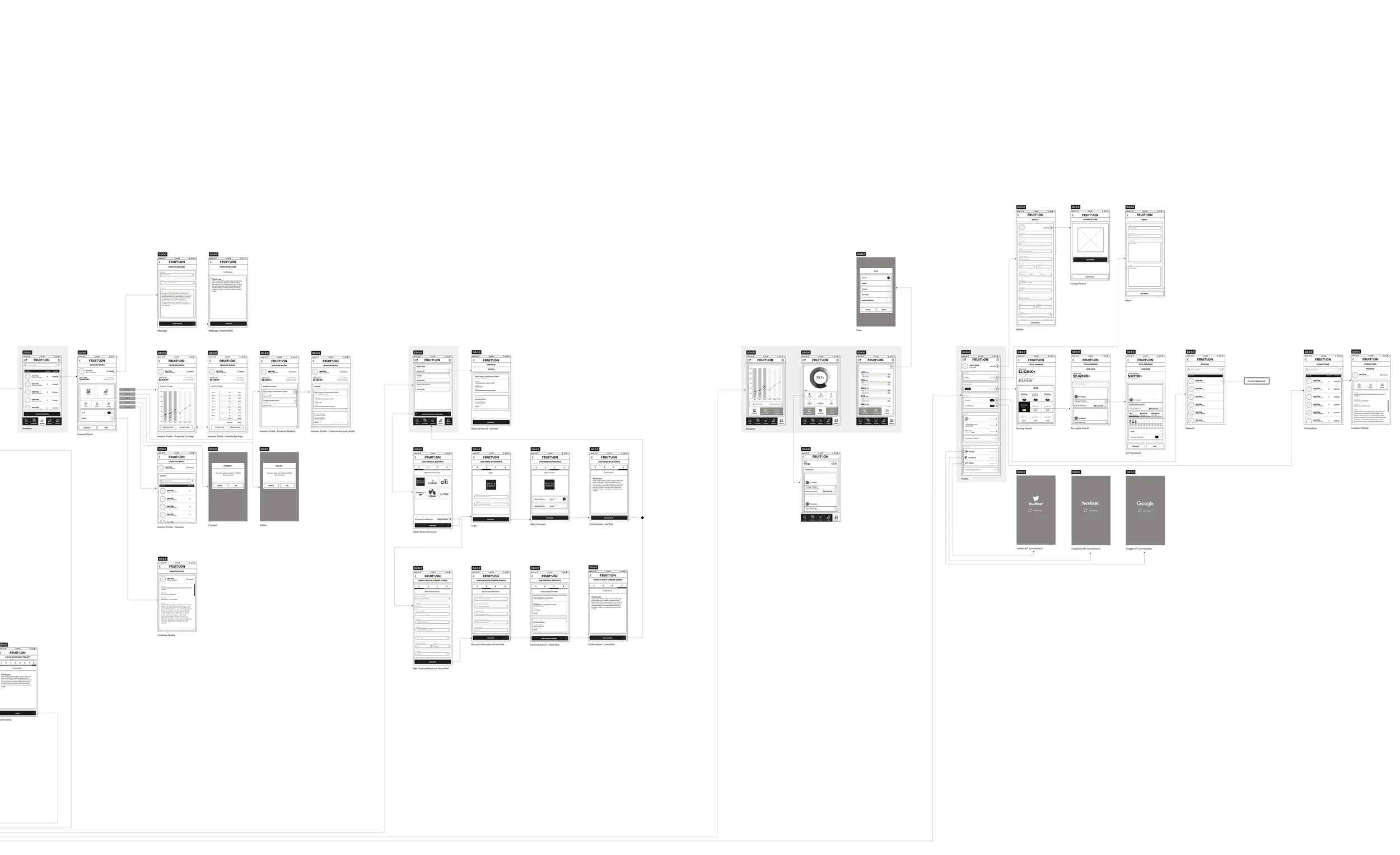Fruitiion, Inc.
Fruitiion is an SEC-accredited real estate syndication mobile app, which organizes the capital of investors and sponsors, manages ownerships fees, and automates distributions in one application. It aims to have a simple and minimalistic design with an emphasis on usability and functionality to gain the trust of individuals with high capital holdings.
Project
Date
December 2017 to December 2020
David Corrales (company COO) approached me to be the lead software designer for a mobile real estate syndication app with a heavy emphasis on analysis of competitive & qualitative data to produce a design that gained the trust of target users and stood out against competing softwares.
ROLE
Freelance UI/UX Designer
I drove design strategy and execution within my scope, functioning as the lead designer and guiding the project from research through delivery.
Team
4 Junior Designers — 2 focused on the Android Flutter app and 2 on the iOS Native Swift application.
Responsibilities
Conducted user and competitive research to inform design direction
Created journey maps, wireframes, and interactive prototypes
Led user testing sessions to validate design concepts and improve usability
Developed visual design systems and refined UI patterns for consistency across platforms
Collaborated with junior designers to ensure cohesive outcomes and alignment with user needs
Tools
Adobe XD, Sketch, InVision Studio, Material Design System Guidelines, Firebase Analytics
Summary
My goal was to create software that simplified the customarily convoluted task of organizing the capital of investors and sponsors, managing ownerships fees, and automating distributions. It had to be perceived as trustworthy. A significant part of the process was analyzing competitive and qualitative data via focus groups as well as perception control with use of design elements such as color, typography, layout, and other elements based on Material Design System guidelines to produce a coherent and competitive product. The latest iteration of the product was ultimately minimalistic and pleasing to the eye yet elegant to use. The results were successful according to focus groups including target audience members above 45 years of age. It was deemed trustworthy, successful at simplifying previously complex tasks in real estate capital management, and perceived as a strong competitor amongst other products currently in the market.
Visual Mock-Ups
Getting Started






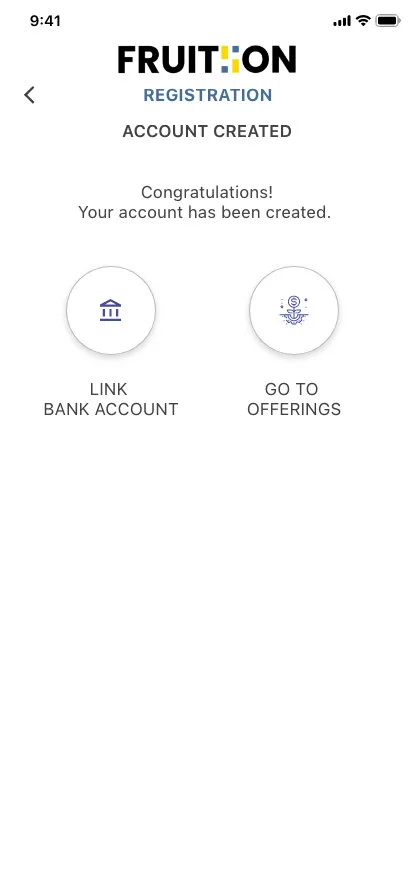

Deals (Sponsor View)









Deals (Investor View)







Deals (Closing)






Account & Messages
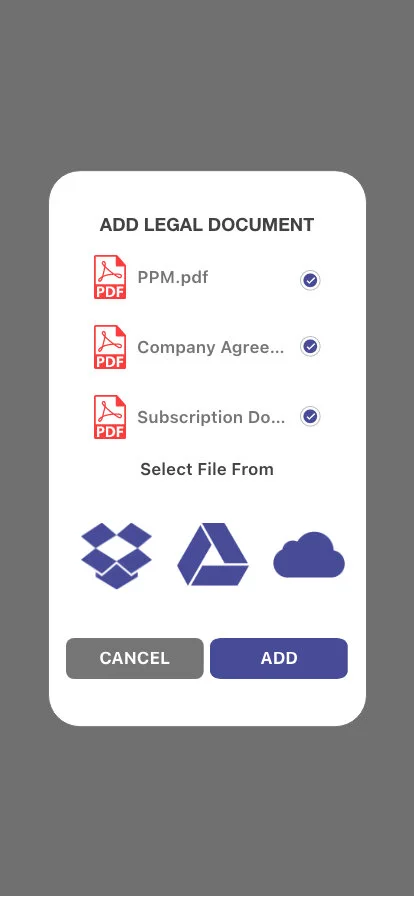




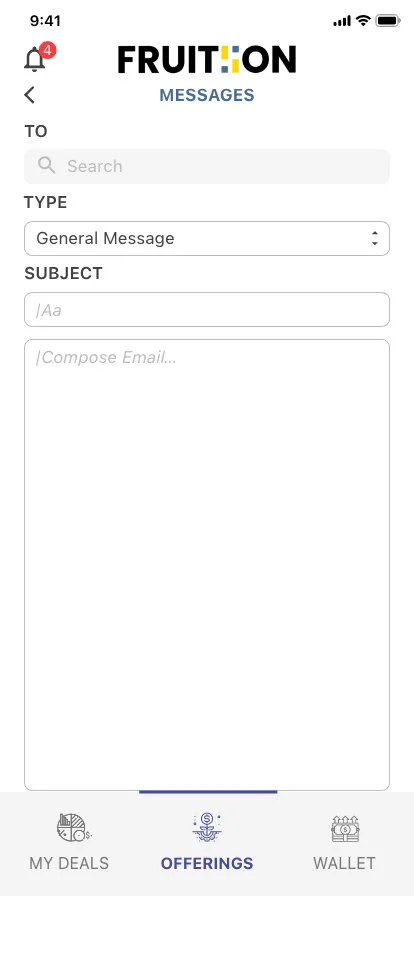

Distributions & Equity Ownership





High-Fidelity
Prototype
The Challenge
Create an app that appeals to the target audience, fulfills user and conceptualized needs and goals, and stands out from the competition.
Target Audience
Accredited investors ($1 million net worth)
Sophisticated investors ($300K salary)
Likely middle-aged or older
Likely white (may include Asian and Indian)
With a college education or higher
Reference: Boshara, R., Emmons, W. R., & Noeth, B. J. (2015, February). The Demographics of Wealth: How Age, Education and Race Separate Thrivers from Strugglers in Today’s Economy. Retrieved December 28, 2017, from https://www.stlouisfed.org/~/media/files/pdfs/hfs/essays/hfs-essay-1-2015-race-ethnicity-and-wealth.pdf
Personality & Attitudes
Responsible
Hardworking
Assertive
Prolific
Proactive
Confident
Busy
Risk tolerant, but discerning
Values
Free market
Social mobility
Opportunities of growth
Security
Expansion of relationships and networks
Effective use of time
Productivity
Limitations on government regulations
Lifestyle & Interests
Boating
Travel
Golf
Art
Politics
Philantrophy
Client Needs
An attractive, smooth, and intuitive application that appeals to target users
An application that gains the trust of target users through design choices and minimal occurrence of bugs or errors within the app
To generate profit and high return on investment for shareholders and owners
To stand out from competitors
Data analytics to track characteristics and behaviors and error reporting of users to allow refinement of future iterations
User Needs
Legible and intuitive software
Secure and reliable application handling large sums of capital
Eliminate extra cost of fees associated with use of automated clearing house
Decreased cost of transactions and increase capital
Accredited software to manage capital and investments
Transparency and direct communication between investors and sponsors
Get automated updates for investments
Ability to choose individual potential assets created by individual sponsors
Competition
Fundrise
Fundrise is an online real estate investment trust (REITs) that allows investors to buy into properties by pooling their assets through this investment platform. It offers eFunds, in which investors’ pooled money is used to buy land, develop housing, and then sell it to home buyers.
Pros: Low minimum investments, open to all investors, easy-to-use website.
Cons: Fees are difficult to understand, investment are highly illiquid, complex investments requiring due dilligence, no mobile application
Crowdstreet
CrowdStreet is a platform that pairs individual investors with project developers. Users can pick individual properties or buy into CrowdStreet’s funds, which consist of a diverse real estate projects.
Pros: Access to commercial deals, high return potential, easy-to-use website
Cons: Steep minimum investments, investments are highly illiquid, available only to accredited investors, no mobile application
RealtyMogul
RealtyMogul is an online real estate investment platform that allows nonaccredited (who have access to two public nontraded REITs) and accredited investors (who have access to private investment in addition to REITs) to invest in commercial deals.
Pros: REIT products are open to nonaccredited investors, REIT buyback program increases liquidity, high targeted rates of return
Cons: High minimums, complex fee structures, short track record, no mobile application
Juniper Square
Juniper Square is an all-in-one web-based platform for commercial real estate investment managers and their individual investors. It streamlines fundraising with real-time access to data and includes Client Relationship Management (CRM).
Pros: easy-to-use website, good customer support, eases communication between investors and managers
Cons: no mobile application, lack of customization of fund structures and web layouts
“It’s the only app-based sponsor driven deal platform. In Fruitiion, you can pick and choose individual deals created by individual sponsors. Competitors such as Fundrise and Realty Mogul, pre-select deals that you can then invest into.
Fruitiion is sort of like the Free-Market which also allows
Investors to deal directly with the Sponsor.”
-David Corrales (Fruitiion COO)
The Conception
An idea come to life.
Process
1.
Ideation
2.
Research and Development.
3.
Mapping and Wireframing.
4.
Visual Mock-Ups.
5.
High-Fidelity Prototyping.
6.
Iterations and Refinement.
Ideation
Meetings with owner and stakeholders on:
Conceptualization which included on opportunities and limitations of a mobile app a real estate syndication platform
Strategy which included delineation of the target audience characteristics, user needs, and client needs (as outlined above)
Outline of scope which included delineation of content requirements and functionality requirements
Identification of goals and targeted outcomes
Fruitiion, Inc. was chosen as the name of the application. According to Oxford Languages, the word fruition is “the point at which a plan or project is realized,” or “the state or action of producing fruit.” We decided to use the double “ii” in the name to visually represent the relationship between the investor and sponsor or the user and the application. Altogether, we wanted the name to suggest to the user that these symbiotic relationships would be “fruitful” and mutually beneficial to all parties involved.
“God said unto them, Be fruitful, and multiply, and replenish the earth, and subdue it: and have dominion over the fish of the sea, and over the fowl of the air, and over every living thing that moveth upon the earth.”
Research & Development
Research was undertaken on:
similar real estate investment software using SWOT Analysis
targeted users
Focus Groups (8-12 People per meeting)
Most thought investing through an app was too hard as font might be too small
Most didn’t think it was possible
Most didn’t trust transferring large sums of money via phone
user needs assessment
available third-party plug-ins that can be used to streamline capital transfers
tools for further user testing in later phases of development
The ideas and goals were refined based on the research findings
The main functions were identified.
Provide a platform that will automate distributions with instant redistribution/allocation to investors.
Organize user equity in each investment.
Allow tracking of all investments in one software.
Provide a platform to advertise real estate deals to accredited and sophisticated investors.
Provide a messaging platform to allow direct communication between investors and sponsors.
Mapping/Wireframing
Based on research and development findings and resolutions, wireframes were created. Each set of wireframes were resent to owners, stakeholders, and focus groups. Wireframe iterations were made and resent. This process was repeated 5-6 times before visual designing was begun.
For a closer look, access the PDF file below:
Results
The next phase includes further iterations and refinements. Some of the successes, thus far, include having locked in a few partners, reception of recognition from CCIM, and a successful preliminary design of a FinTech start-up. Lessons learned include the importance of focus groups and qualitative analysis for software development and opportunities include increasing amount of actual user research before sending the final designs to coders for programming.
